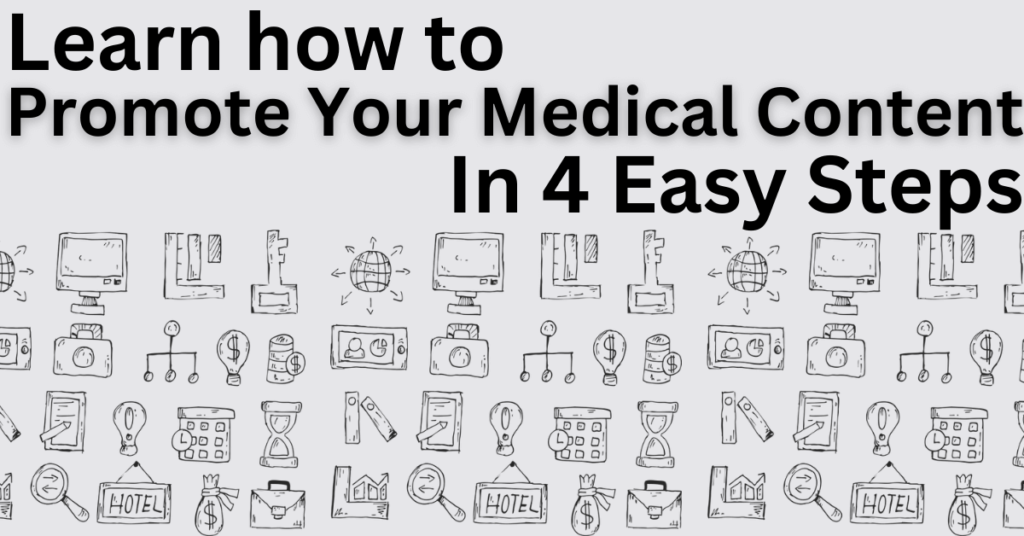Content is king. That’s especially true when it comes to healthcare. Medical content marketing can help doctors build trust, educate patients, and boost online visibility. It’s more than just writing blog posts or creating social media updates. It’s about creating valuable, informative, and engaging content that patients find useful.
As a doctor, you may wonder how content marketing fits into your practice. Let me tell you—it’s a game-changer. In this guide, we’ll dive deep into what medical content marketing is, why it matters for your practice, and how you can start leveraging it to engage more patients.
Table of Contents
What is Medical Content Marketing?
Medical content marketing involves creating and sharing educational, informative content aimed at patients, healthcare providers, or even other medical professionals. This content can come in many forms, such as blog posts, videos, infographics, podcasts, or social media updates.
Why is this important? Because patients are constantly searching online for answers to their health concerns. They’re reading blogs, watching videos, and looking for reliable information to make better decisions about their health. When you provide that information, you position yourself as a trusted expert.
The Benefits of Medical Content Marketing
Content marketing offers many benefits for your practice:
- Builds Trust: When patients see you regularly sharing valuable information, they begin to trust your expertise.
- Improves SEO: High-quality content can help your website rank higher on Google, driving more traffic to your site.
- Engages Patients: Content can be a way to educate patients about their health conditions, treatments, and procedures.
- Differentiates You from Competitors: Not all doctors use content marketing effectively. By doing so, you can set yourself apart.
If you’re ready to start, here’s how you can create an effective content marketing strategy for your practice.
How to Create a Medical Content Marketing Strategy
Creating a medical content marketing strategy doesn’t have to be complicated. Follow these simple steps to get started.
1. Define Your Audience
Before creating any content, you need to know who you’re speaking to. Are you targeting patients with specific health conditions? Maybe you’re trying to attract a general audience interested in wellness. The better you know your audience, the more relevant and valuable your content will be.
Ask yourself:
- What are my patients’ most common concerns?
- What questions do they ask me in the office?
- What do they need help understanding?
2. Set Clear Goals
Your content marketing should have a clear purpose. What do you want to achieve with your content? Are you looking to attract new patients, educate current ones, or increase engagement on social media?
Some common goals for medical content marketing include:
- Increasing website traffic
- Building brand awareness
- Educating patients about a specific condition
- Promoting a new service or treatment
- Improving patient engagement
Once your goals are set, it’s time to think about the types of content you’ll create.

Types of Medical Content You Should Create
There’s no shortage of content formats you can use, but not all content will be relevant to your audience. Focus on the types of content that provide the most value to your patients and fit your goals.
1. Blog Posts
Blogging is one of the most effective forms of content marketing. By regularly publishing blog posts, you can offer helpful insights, answer common questions, and position yourself as an authority in your field.
For example, if you’re a dermatologist, you could write blog posts on common skin conditions, how to treat acne, or the benefits of certain skincare treatments. This educational content not only helps your current patients but can also attract new ones.
2. Videos
Not everyone has time to read long blog posts. That’s where videos come in. Video content is engaging and easy to digest. You can create short educational videos explaining a procedure or offering health tips.
For example, a cardiologist could create a video series about heart health, covering topics like managing cholesterol, the importance of exercise, and understanding common heart conditions.
3. Infographics
Infographics are a visual way to present data or explain complex topics in an easy-to-understand format. If you’re trying to explain something detailed—like the stages of a medical procedure or the benefits of a treatment—an infographic can make it more digestible.
4. Patient Testimonials
Testimonials from satisfied patients can be powerful content. Potential patients trust the experiences of others when choosing a doctor. You can feature these stories on your website or social media, showcasing how your care has positively impacted lives.
5. E-books and Guides
If you’re an expert in a particular field, why not compile your knowledge into a downloadable guide or e-book? For example, a dentist could offer a guide on maintaining oral hygiene or managing dental anxiety. Offering these in exchange for email sign-ups can help grow your practice’s email list.
Optimizing Your Content for SEO
Now that you have content ideas, it’s time to ensure they reach your audience. That’s where Search Engine Optimization (SEO) comes in. If your content isn’t optimized for search engines, it won’t appear in front of patients when they search for health-related information online.
1. Keyword Research
Start by identifying the keywords your patients are searching for. These could be general health questions or specific queries related to your specialty. Tools like Google Keyword Planner or Ubersuggest can help.
For example, if you’re an orthopedic surgeon, potential keywords might include:
- “knee replacement surgery”
- “best exercises for joint pain”
- “orthopedic doctor near me”
Once you’ve identified your keywords, use them naturally in your content, especially in headings, meta descriptions, and image alt text.
2. Write for Humans, Not Just Search Engines
Yes, SEO is important. But your content should always be written for your audience first. Google rewards content that is helpful, informative, and user-friendly. So, avoid keyword stuffing and focus on providing value to your readers.
3. Optimize for Mobile Devices
Most patients will access your content on their smartphones. Make sure your website is mobile-friendly, and your content looks good on smaller screens. Google favors mobile-optimized content, so this will also boost your SEO efforts.
How to Promote Your Medical Content

Creating great content is only half the battle. You also need to promote it. If no one sees your content, it won’t have the desired impact. Here’s how you can get your content in front of more eyes.
1. Share on Social Media
Social media is one of the best ways to distribute your content. Platforms like Facebook, Instagram, and LinkedIn are perfect for sharing blog posts, videos, and infographics. When you post regularly, you keep your audience engaged and drive traffic back to your website.
2. Email Marketing
Building an email list is one of the most valuable assets in your content marketing strategy. Use email newsletters to share your latest blog posts, patient success stories, and health tips. This keeps your patients informed and engaged.
3. Collaborate with Influencers
Consider collaborating with healthcare influencers or other professionals in your field. This can expand your reach and introduce you to new audiences. For example, you could write a guest blog for a popular healthcare website or participate in a podcast interview.
4. Encourage Patient Sharing
If your content is valuable, patients will likely share it with others. Encourage sharing by including social sharing buttons on your blog posts and other content pieces.
Measuring the Success of Your Medical Content Marketing
Finally, you’ll want to track the effectiveness of your content marketing strategy. You can measure success by tracking key performance indicators (KPIs) such as:
- Website Traffic: Has your content brought more visitors to your website?
- Engagement: Are patients commenting on and sharing your content?
- Lead Generation: Is your content helping you collect more email addresses or patient inquiries?
- SEO Performance: Are your pages ranking higher in search results?
Regularly analyzing these metrics will help you understand what’s working and what needs improvement.
Conclusion: The Power of Medical Content Marketing
In conclusion, medical content marketing is an invaluable tool for any healthcare provider. By creating and promoting informative, engaging, and trustworthy content, you can position yourself as a leader in your field, build stronger relationships with patients, and grow your practice.
Start small by creating content that answers the questions your patients are already asking. With consistency, you’ll see the impact on your practice over time.
Remember, you’re not just a doctor—you’re also an educator, a communicator, and an advocate for your patients’ health.
FAQs on Medical content marketing
1. What is Medical Content Marketing?
Medical content marketing involves creating and sharing valuable, informative content related to healthcare. It’s a way for doctors and medical practices to educate patients, build trust, and increase visibility online. This content can include blog posts, videos, social media updates, infographics, and more.
2. Why is Medical Content Marketing Important for Doctors?
In today’s digital world, patients search online for health information before making decisions. By providing reliable, helpful content, you position yourself as an expert. This helps build trust, attract more patients, and improve your practice’s online presence. Content marketing also enhances your SEO, making it easier for patients to find you.
3. What Types of Content Should Doctors Create?
Doctors should focus on creating educational content that answers common patient questions. Blog posts, videos, infographics, and patient success stories are great options. You can explain medical conditions, treatments, or health tips in a way that’s easy for patients to understand. The goal is to provide value while showcasing your expertise.
4. How Can Medical Content Marketing Improve SEO?
By consistently publishing relevant, high-quality content, you improve your website’s SEO. When patients search for health information, Google ranks websites with authoritative content higher. Including important keywords related to your practice, such as “cardiology care” or “back pain treatment,” helps boost your search engine rankings and attract more traffic.
5. How Often Should I Post Medical Content?
Consistency is key in content marketing. While there’s no one-size-fits-all answer, aim to post valuable content at least once a week. The more frequently you post, the more likely patients will return to your website or social media pages. Regular posting also signals to search engines that your website is active and relevant.
6. How Can I Make My Medical Content Engaging?
To make your content engaging, keep it simple, relatable, and patient-centered. Use real-life examples, patient success stories, and visuals to make your content more appealing. Break up large chunks of text with bullet points or images. Also, encourage interaction by asking questions or inviting patients to comment and share their experiences.
7. Can Medical Content Marketing Help Attract New Patients?
Yes! When you provide helpful, trustworthy content, patients are more likely to trust your expertise and choose you as their doctor. By sharing your knowledge and answering patients’ questions online, you attract new patients who are searching for reliable healthcare information. It’s a great way to grow your practice organically.




